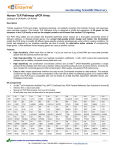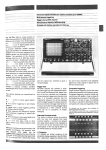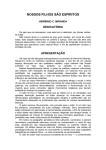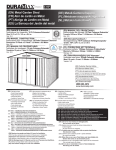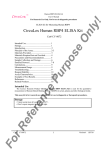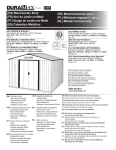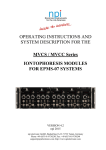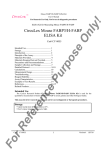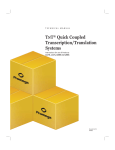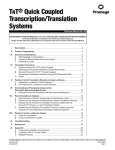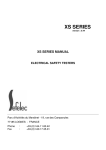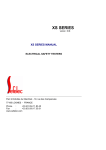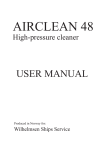Download CY-1184
Transcript
t. uc od ur pr PKR/EIF2AK2 Kinase Assay Kit User’s Manual For Research Use Only, Not for use in diagnostic procedures ith yo Non-Radioisotopic Kit for Measuring PKR/EIF2AK2 Activity ew CycLex PKR/EIF2AK2 Kinase Assay Kit ca at th al an u rm se fe rt o th eu Intended Use................................................ 1 Storage......................................................... 1 Introduction.................................................. 2 Principle of the Assay.................................. 2-3 Materials Provided....................................... 4 Materials Required but not Provided........... 5 Precautions and Recommendations............. 6 Detailed Protocol......................................... 7-13 Evaluation of Results..................…............ 14 Assay Characteristics.................................. 14 Troubleshooting........................................... 14 Reagent Stability.......................................... 14 Sample Preparation...................................... 15-16 Example of Test Result.................................17-20 References.................................................... 21-22 Related Products.......................................... 22 m Cat# CY-1184 re Intended Use nl y! Pl ea se The CycLex Research Product CycLex PKR/EIF2AK2 Kinase Assay Kit is primarily designed to measure the activities of purified RNA-dependent protein kinase (PKR) or recombinant PKR for the rapid and sensitive evaluation of inhibitors or activators. The phospho-serine specific monoclonal antibody used in this assay kit has been demonstrated to recognize the phosphorylated serine 51 in Eukaryotic Initiation Factor 2α (eIF2α), which is efficiently phosphorylated by PKR. Additionally, column fractions of cultured primary cells, cell lines, or tissues can be assayed for PKR activity with the CycLex Research Product CycLex PKR/EIF2AK2 Kinase Assay Kit if the appropriate dose of PKR specific inhibitor, e.g. C16, is used. Pu rp os eO Applications of this kit include: 1) Screening inhibitors or activators of PKR/EIF2AK2. 2) Evaluating the effects of pharmacological agents on PKR/EIF2AK2 activity in vitro. 3) Monitoring the purification of the kinase activity of PKR/EIF2AK2. This assay kit is for research use only and not for use in diagnostic or therapeutic procedures. Storage er en ce • Upon receipt store all components at 4°C. • Don’t expose reagents to excessive light. Fo rR ef Cat#: CY-1184 1 Version#: 150807 t. uc od yo ur pr PKR/EIF2AK2 Kinase Assay Kit User’s Manual For Research Use Only, Not for use in diagnostic procedures ith Introduction rm an u al th at ca m ew The double-stranded RNA-activated protein kinase (PKR), also known as eukaryotic translation initiation factor 2-alpha kinase 2 (EIF2AK2), is a ubiquitously expressed serine/threonine protein kinase that plays a key role in the innate immunity response to viral infection in higher eukaryotes and has also been implicated in several cellular signal transduction pathways (1-4). The dsRNAs-mediated activation leads to autophosphorylation of PKR and allows the kinase to phosphorylate its natural substrate, the α-subunit of initiation factor eIF2, resulting in rapid inhibition of translation and suppression of virus spread (5, 6). PKR also has been implicated in regulating other cellular functions such as differentiation (7), transcription (8, 9), signal transduction (10), cell growth (11, 12) and apoptosis in the event of virus infection and other forms of cellular stress. (13-15). It was reported that the activation of PKR in adipose and liver tissue is caused by obesity (16). In the absence of PKR, metabolic deterioration due to excess energy or nutrition is alleviated. These findings demonstrate that PKR is an important component of inflammation complex that responds to nutrients and organelle dysfunction. Principle of the Assay er en ce Pu rp os eO nl y! Pl ea se re fe rt o th eu se The CycLex Research Product CycLex PKR/EIF2AK2 Kinase Assay Kit is a semi-quantitative immunoassay for the kinase activity of PKR. This product can be used to determine the presence of the kinase activity in purification column fractions or to follow the kinetics of a purified or partially purified PKR protein as well as screening PKR inhibitors or activators. The protocol for the quantitative measurement of the kinase activity involves incubation of the PKR sample with its substrate, GST-eIF2α fusion protein, in the presence of Mg2+and ATP, followed by transfer this kinase reaction mixture to the well of microtiter plate, which is pre-coated with a monoclonal antibody specific for phospho-eIF2α-S51 for trapping only phosphorylated substrate. The amount of phosphorylated substrate on the well is measured by a horseradish peroxidase coupled anti-GST antibody, which then catalyzes the conversion of the chromogenic substrate tetra-methylbenzidine (TMB) from a colorless solution to a blue solution (or yellow after the addition of stopping reagent). The color is quantified by spectrophotometry and reflects the relative amount of the kinase activity in the sample. For kinetic analysis, the sample containing PKR is added to the wells in a similar fashion and at varying times the reaction is stopped by the addition of a chelator, sodium ethylenediaminetetraacetate (EDTA) and the amount of phosphorylated substrate determined as mentioned before. The CycLex Research Product CycLex PKR/EIF2AK2 Kinase Assay Kit is designed to accurately determine the presence and relative amount of PKR activity in purification column fractions and to determine non-isotopic kinetic analysis of the kinase activity of PKR. Careful attention to extraction methods and the assay protocol will provide the investigator with a reliable tool for the evaluation of the kinase activity. Fo rR ef Cat#: CY-1184 2 Version#: 150807 t. uc od yo ur pr PKR/EIF2AK2 Kinase Assay Kit User’s Manual For Research Use Only, Not for use in diagnostic procedures ith Summary of Procedure ew Add 100 µL of reaction mixtures to the non-coated wells. at ca m Incubate for 1 hour at 30°C. an u al th Add of 10 µL of EDTA Solution to stop kinase reaction. rm Transfer 100 µL of reaction mixtures to the antibody-coated wells. th eu se Incubate for 1 hour at room temp. re fe rt o Wash the wells. Incubate for 1 hour at room temp. nl y! Pl ea se Add 100 µL of HRP conjugated anti-GST antibody. er en ce Pu rp os eO Wash the wells. Fo rR ef Cat#: CY-1184 Add 100 µL of Substrate Reagent. Incubate for 5 to 20 minutes at room temp. Add 100 µL of Stop Solution. Measure absorbance at 450 nm. 3 Version#: 150807 t. uc od yo ur pr PKR/EIF2AK2 Kinase Assay Kit User’s Manual For Research Use Only, Not for use in diagnostic procedures ith Materials Provided ew All samples and standards should be assayed in duplicate. The following components are supplied and are sufficient for the one 96-well microplate kit. ca m Non-coated Microplate for kinase reaction: One microplate supplied ready to use, with 96 wells (12 strips of 8-wells) in a clear, zip-lock bag. th at Antibody-coated Microplate: One microplate supplied ready to use, with 96 wells (12 strips of 8-wells) in a foil, zip-lock bag with a desiccant pack. Wells are coated with anti-phospho-eIF2α serine 51 monoclonal antibody as a capture antibody. al 10X Wash Buffer: One bottle containing 100 mL of 10X buffer containing Tween®-20 rm an u Kinase Buffer: One bottle containing 20 mL of 1X buffer, used for Reaction Buffer and sample dilution. 20X ATP: One vial of lyophilized ATP Na2 salt. eu se 20X DTT: Four vials of lyophilized dithiothreitol. 10X GST-eIF2α Substrate: One vial containing 37.5 ng of lyophilized recombinant GST-eIF2α. th EDTA Solution: One vial containing 2 mL of 0.5 M EDTA, pH 8.0. Ready to use. fe rt o HRP conjugated Detection Antibody: One bottle containing 12 mL of HRP (horseradish peroxidase) conjugated anti-GST antibody. Ready to use. se re Substrate Reagent: One bottle containing 20 mL of the chromogenic substrate, tetra-methylbenzidine (TMB). Ready to use. er en ce Pu rp os eO nl y! Pl ea Stop Solution: One bottle containing 20 mL of 1 N H2SO4. Ready to use. Fo rR ef Cat#: CY-1184 4 Version#: 150807 t. uc od yo ur pr PKR/EIF2AK2 Kinase Assay Kit User’s Manual For Research Use Only, Not for use in diagnostic procedures ith Materials Required but not Provided ew • Orbital microplate shaker • Pipettors: 2-20 µL, 20-200 µL and 200-1000 µL precision pipettors with disposable tips ca m • Wash bottle or multichannel dispenser for plate washing. at • Microcentrifuge and tubes for sample preparation th • Vortex mixer al • Microplate washer: optional (Manual washing is possible but not preferable) rm an u • Plate reader: capable of measuring absorbance in 96-well plates at dual wavelengths of 450 nm/540 nm. Dual wavelengths of 450/550 or 450/595 nm can also be used. The plate can also be read at a single wavelength of 450 nm, which will give a somewhat higher reading. se • (Optional) Software package facilitating data generation and analysis eu • 500 or 1000 mL graduated cylinder th • Reagent reservoirs o • Deionized water of the highest quality fe rt • Disposable paper towels se re • PKR/EIF2 (Catalytic domain): Available from CycLex Co., Ltd., PKR/EIF2AK2 (Human), Active, Cat#CY-SPP80 ea • PKR/EIF2 (Full length): Available from CycLex Co., Ltd., PKR/EIF2AK2 Positive Control (Full length), Cat#CY-E1184-1 nl y! Pl • (Optional) BSA-containing dilution buffer: 20mM Hepes-KOH (pH 7.5), 1% BSA, 1mM EDTA, 2mM DTT, 50mM NaCl and 50% glycerol eO • (Optional) C16 (10 µM): A specific inhibitor of PKR. Available from Sigma, Cat#I9785. Make 1 mM stock solution with DMSO and dilute 1:100 with Kinase Buffer. os • (Optional) Poly I:C (Polyinosinic-polycytidylic acid sodium salt): A synthetic analog of double-stranded RNA (dsRNA). Available from Sigma, Cat#P1530 Pu rp • (Optional) Phosphatase inhibitor cocktail: Available from Cell Signaling Technology, Inc., Cat#5871 er en ce • (Optional) Anti-PKR antibody: Available from CycLex Co., Ltd., Cat#CY-P1043 Fo rR ef Cat#: CY-1184 5 Version#: 150807 t. uc od yo ur pr PKR/EIF2AK2 Kinase Assay Kit User’s Manual For Research Use Only, Not for use in diagnostic procedures ith Precautions and Recommendations ew • Allow all the components to come to room temperature before use. m • All microplate strips that are not immediately required should be returned to the zip-lock pouch, which must be carefully resealed to avoid moisture absorption. ca • Do not use kit components beyond the indicated kit expiration date. at • Use only the microtiter wells provided with the kit. al th • Rinse all detergent residue from glassware. an u • Use deionized water of the highest quality. rm • Do not mix reagents from different kits. se • The buffers and reagents in this kit may contain preservatives or other chemicals. Care should be taken to avoid direct contact with these reagents. eu • Do not mouth pipette or ingest any of the reagents. th • Do not smoke, eat, or drink when performing the assay or in areas where samples or reagents are handled. rt o • Dispose of tetra-methylbenzidine (TMB) containing solutions in compliance with local regulations. re fe • Avoid contact with the acidic Stop Solution and Substrate Solution, which contains hydrogen peroxide. ea se • Wear gloves and eye protection when handling immunodiagnostic materials and samples of rat origin, and these reagents. In case of contact with the Stop Solution and the Substrate Solution, wash skin thoroughly with water and seek medical attention, when necessary. Pl • Biological samples may be contaminated with infectious agents. Do not ingest, expose to open wounds or breathe aerosols. Wear protective gloves and dispose of biological samples properly. er en ce Pu rp os eO nl y! • CAUTION: Sulfuric Acid is a strong acid. Wear disposable gloves and eye protection when handling Stop Solution. Fo rR ef Cat#: CY-1184 6 Version#: 150807 t. uc od yo ur pr PKR/EIF2AK2 Kinase Assay Kit User’s Manual For Research Use Only, Not for use in diagnostic procedures ith Detailed Protocol ca m ew The CycLex PKR/EIF2AK2 Kinase Assay Kit is provided with removable strips of wells so the assay can be carried out on separate occasions using only the number of strips required for the particular determination. Since conditions may vary, running an aliquot of the appropriate PKR Positive Control should be included in each assay. Disposable pipette tips and reagent troughs should be used for all transfers to avoid cross-contamination of reagents or samples. at 1. Preparation of Working Solutions an u al th 1) Prepare a working solution of Wash Buffer by adding 100 mL of the 10X Wash Buffer to 900 mL of deionized (distilled) water (ddH2O). Mix well. Store at 4°C for two weeks or -20°C for long-term storage. rm 2) Prepare 20X ATP Solution by adding 1.6 mL of ddH2O to the vial of 20X ATP (lyophilized). Mix gently until dissolved. The final concentration of the 20X ATP Solution should be 1.25 mM. Store the solution in small aliquots (e.g. 200 µL) at -20°C. eu se 3) Prepare 20X DTT Solution by adding 0.25 mL of ddH2O to the vial of 20X DTT (lyophilized). Mix gently until dissolved. The final concentration of the 20X DTT Solution should be 200 mM. Store the solution in small aliquots (e.g. 50 µL) at -20°C. rt o th 4) Prepare 10X GST-eIF2α Substrate Solution by adding 0.6 mL of ddH2O to the vial of GST-eIF2α Substrate (lyophilized). Mix gently until dissolved. The final concentration of the 10X GST-eIF2α Substrate Solution should be 62.5 µg/mL. Store the solution in small aliquots (e.g. 100 µL) at -20°C. fe 5) Prepare PKR Positive Control(s). re Catalytic Domain PKR Pl ea se 1st step: Dilute the “PKR/EIF2 (Catalytic domain)” (not provided. See the section “Materials Required but not Provided” above) with “BSA-containing dilution buffer” (not provided. See the section “Materials Required but not Provided” above) to be ~100 ng/µL. nl y! 2nd step: Dilute 1st step enzyme solution 1:5 with Kinase Buffer. Make sure a final concentration of the PKR/EIF2 (Catalytic domain) must be ~20 ng/µL. eO Full Length PKR er en ce Pu rp os Dilute “PKR/EIF2 (Full length)” (not provided. See the section “Materials Required but not Provided” above) with Kinase Buffer to be ~1 units/µL. Fo rR ef Cat#: CY-1184 7 Version#: 150807 t. uc od ur pr PKR/EIF2AK2 Kinase Assay Kit User’s Manual For Research Use Only, Not for use in diagnostic procedures yo 6) Prepare Reaction Buffers for kinase reaction. ith Reaction Buffer (Poly I:C minus) Kinase Buffer 10X GST-eIF2α Substrate Solution 20X DTT Solution 20X ATP Solution 8.0 mL 1.0 mL 0.5 mL 0.5 mL 800 µL 100 µL 50 µL 50 µL Total 10 mL 1,000 µL th al 80 µL 10 µL 5 µL 5 µL 100 µL rm Reaction Buffer (Poly I:C plus) 1 assay ca 10 assays at 96 assays an u Components m ew For assays with Catalytic Domain PKR, prepare Reaction Buffer (Poly I:C minus) (Quantity required: 90 µL/assay). Mix following components. Discard any unused the buffer after use. eu se For assays with Full Length PKR or native PKR sample, prepare Reaction Buffer (Poly I:C plus) (Quantity required: 90 µL/assay). Mix following components. Discard any unused the buffer after use. 96 assays o re fe rt Kinase Buffer 10X GST-eIF2α Substrate Solution 20X DTT Solution 20X ATP Solution 5µg/mL poly I:C * th Components 8.0 mL 1.0 mL 0.5 mL 0.5 mL 20 µL 10 assays 1 assay 800 µL 100 µL 50 µL 50 µL 2 µL 80 µL 10 µL 5 µL 5 µL 0.2 µL ea se Total 10.02 mL 1,002 µL 100.2 µL * Not provided. See the section “Materials Required but not Provided” above Pl Reaction Buffer (ATP/ Poly I:C minus) nl y! For assays of precise PKR activity, prepare Reaction Buffer (ATP/Poly I:C minus) (Quantity required: 90 µL/assay). Mix following components. Discard any unused the buffer after use. 96 assays 10 assays 1 assay Kinase Buffer 10X GST-eIF2α Substrate Solution 20X DTT Solution ddH2O 8.0 mL 1.0 mL 0.5 mL 0.5 mL 800 µL 100 µL 50 µL 50 µL 80 µL 10 µL 5 µL 5 µL Total 10 mL 1,000 µL 100 µL er en ce Pu rp os eO Components Fo rR ef Cat#: CY-1184 8 Version#: 150807 t. uc od yo ur pr PKR/EIF2AK2 Kinase Assay Kit User’s Manual For Research Use Only, Not for use in diagnostic procedures 2. Standard Assay ew ith 1) Remove the appropriate number of Non-coated Microplate and Antibody-coated Microplate wells from the pouch and place them into the well holder. Return any unused wells to the foil pouch, refold, seal with tape and store at 4°C. ca m 2) Prepare all samples (diluted with Kinase Buffer as needed). at 3) Add 10 µL of sample and PKR Positive Control (See the “5) Prepare PKR Positive Control(s).” in “1. Preparation of Working Solution” above.) to each well of Non-coated Microplate on ice. an u al th 4) Start the kinase reaction by addition of 90 µL of Reaction Buffer* to each well, cover with plate sealer or lid, and incubate at 30°C for 60 minutes shaking at ca. 300 rpm on an orbital microplate shaker. rm * Select the suitable Reaction Buffer, Poly I:C plus or Poly I:C minus, for the type of sample and PKR Positive control. See the “6) Prepare Reaction Buffer for kinase reaction.” in “1. Preparation of Working Solution” above. eu se 5) Stop the kinase reaction by addition of 10 µL of EDTA Solution to each well. Mix well by pipetting. o th 6) Transfer 100 µL of the reaction mixture to each well of the Antibody-coated Microplate, cover with plate sealer or lid, and incubate at room temperature (ca.25°C) for 60 minutes shaking at ca. 300 rpm on an orbital microplate shaker. fe rt 7) Wash five times by filling each well with Wash Buffer. Remove residual Wash Buffer by gentle tapping or aspiration. se re 8) Pipette 100 µL of HRP-conjugated Detection Antibody to each well, cover with plate sealer or lid, and incubate at room temperature (ca.25°C) for 60 minutes shaking at ca. 300 rpm on an orbital microplate shaker. Pl ea 9) Wash five times by filling each well with Wash Buffer. Remove residual Wash Buffer by gentle tapping or aspiration. nl y! 10) Add 100 µL of Substrate Reagent to each well and incubate at room temperature (ca.25°C) for 5-20 minutes shaking at ca. 300 rpm on an orbital microplate shaker. os eO 11) Add 100 µL of Stop Solution to each well in the same order as the previously added Substrate Reagent. er en ce Pu rp 12) Measure absorbance in each well using a spectrophotometric plate reader at dual wavelengths of 450/540 nm. Dual wavelengths of 450/550 or 450/595 nm can also be used. Read the plate at 450 nm if only a single wavelength can be used. Wells must be read within 30 minutes of adding the Stop Solution. Fo rR ef Cat#: CY-1184 9 Version#: 150807 t. uc od yo ur pr PKR/EIF2AK2 Kinase Assay Kit User’s Manual For Research Use Only, Not for use in diagnostic procedures ew ith Note-1: Complete removal of liquid at each step is essential to good performance. After the last wash, remove any remaining Wash Buffer by aspirating or decanting. Invert the plate and blot it against clean paper towels. ca m Note-2: Reliable signals are obtained when either O.D. values do not exceed 0.25 units for the blank (no enzyme control), or 2.5 units for Positive Controls. er en ce Pu rp os eO nl y! Pl ea se re fe rt o th eu se rm an u al th at Note-3: If the microplate reader is not capable of reading absorbance greater than the absorbance of Positive Controls, perform a second reading at 405 nm. A new O.D. values, measured at 405 nm, is used to determine PKR activity of off-scale samples. The readings at 405 nm should not replace the on-scale readings at 450 nm. Fo rR ef Cat#: CY-1184 10 Version#: 150807 t. uc od yo ur pr PKR/EIF2AK2 Kinase Assay Kit User’s Manual For Research Use Only, Not for use in diagnostic procedures 3. Recommendations at ca m ew ith I. Special considerations for screening inhibitors In order to estimate the inhibitory effect on PKR activity in your test compounds correctly, it is necessary to conduct the control experiment of “Solvent Control Assay” at least once for every experiment and “Inhibitor Control Assay” at least once for the first experiment, in addition to “Test Compound Assay”, as indicated in the following table. When test compounds cause an inhibitory effect on PKR activity, the level of “Test Compound Assay” weaken as compared with “Solvent Control Assay”. Test Compound Solvent of Test Compound C16 (10 µM) ** 10 µL - Catalytic Domain PKR *** 10 µL al rm 80 µL Inhibitor Control Assay 80 µL 80 µL 10 µL -- 10 µL 10 µL 10 µL eu se Reaction Buffer (Poly I:C minus) * Solvent Control Assay an u Test Compound Assay Assay Reagents th Inhibitor screening using Catalytic Domain PKR rt o th * See the “6) Prepare Reaction Buffers for kinase reaction.” in “1. Preparation of Working Solution” above. ** See the section “Materials Required but not Provided” above. *** ~20 ng/µL of Catalytic Domain PKR. See the section “Materials Required but not Provided” and “5) Prepare Positive Control(s)” in “1. Preparation of Working Solution” above. se re fe 1) Following the table above, add the reagents to each well of the Non-coated Microplate. Finally, initiate reaction by adding 10 µL of Catalytic Domain PKR to each well and mixing thoroughly at room temperature. Cover with plate sealer or lid, and incubate at 30°C for 60 minutes shaking at ca. 300 rpm on an orbital microplate shaker. ea 2) Follow the step 5) to 12) of “2. Standard Assay” above. er en ce Pu rp os eO nl y! Pl Note: Although we suggest to conduct experiments as outlined in the table above, the optimal experimental conditions will vary depending on the parameters being investigated, and must be determined by the individual user. Especially, an appropriate amount of the enzyme must be optimized by titration of the enzyme and setting the amount, which shows OD value does not exceed plateau range in dose response curve. Fo rR ef Cat#: CY-1184 11 Version#: 150807 t. uc od ur pr PKR/EIF2AK2 Kinase Assay Kit User’s Manual For Research Use Only, Not for use in diagnostic procedures yo Inhibitor screening using Full Length PKR or native PKR samples Reaction Buffer (Poly I:C plus) * 80 µL 80 µL Test Compound Solvent of Test Compound C16 (10 µM) ** 10 µL - 10 µL -- Full Length PKR *** (or native PKR sample) 10 µL 10 µL Inhibitor Control Assay ith Solvent Control Assay ew Test Compound Assay at ca m 80 µL 10 µL 10 µL th Assay Reagents rm an u al * See the “6) Prepare Reaction Buffers for kinase reaction” in “1. Preparation of Working Solution” above. ** See the section “Materials Required but not Provided” above. *** ~1 units/µL of Full Length PKR. See the section “Materials Required but not Provided” and “5) Prepare Positive Control(s)” in “1. Preparation of Working Solution” above. eu se 1) Following the table above, add the reagents to each well of the Non-coated Microplate. Finally, initiate reaction by adding 10 µL of Full Length PKR (or your native PKR sample) to each well and mixing thoroughly at room temperature. Cover with plate sealer or lid, and incubate at 30°C for 60 minutes shaking at ca. 300 rpm on an orbital microplate shaker. th 2) Follow the step 5) to 12) of “2. Standard Assay” above. er en ce Pu rp os eO nl y! Pl ea se re fe rt o Note: Although we suggest to conduct experiments as outlined in the table above, the optimal experimental conditions will vary depending on the parameters being investigated, and must be determined by the individual user. Especially, an appropriate amount of the enzyme must be optimized by titration of the enzyme and setting the amount, which shows OD value does not exceed plateau range in dose response curve. Fo rR ef Cat#: CY-1184 12 Version#: 150807 t. uc od ur pr PKR/EIF2AK2 Kinase Assay Kit User’s Manual For Research Use Only, Not for use in diagnostic procedures Test Sample Assay Inhibitor Control Assay ATP Minus Control Assay Positive Control Assay No Enzyme Control Assay Reaction Buffer (Poly I:C plus or minus) * 80 µL 80 µL - 80 µL 80 µL Reaction Buffer (ATP/ Poly I:C minus) ** - - 80 µL - - C16 (10 µM) *** Solvent of C16 (10 µM) 10 µL 10 µL - 10 µL 10 µL 10 µL native PKR sample PKR Positive Control **** Buffer of native PKR sample 10 µL - 10 µL - 10 µL - 10 µL - 10 µL th eu se rm an u al th at Assay Reagents ca m ew ith yo II. Special considerations for measuring precise PKR activity In order to measure the activity of PKR correctly, it is necessary to conduct the control experiment of “Inhibitor Control Assay” at least once for every experiment and “ATP Minus Control Assay” at least once for the first experiment, in addition to “No Enzyme Control Assay” as indicated in the following table. The level of A450 increases in “Test Sample Assay” when the sample contains PKR enzyme activity, although the high levels of A450 are not observed in “Inhibitor Control Assay”, “ATP Minus Control Assay” and “No Enzyme Control Assay”. re fe rt o * Select the suitable Reaction Buffer, Poly I:C plus or Poly I:C minus, for the type of PKR Positive control. See the “6) Prepare Reaction Buffers for kinase reaction.” in “1. Preparation of Working Solutions” above. ** See the “6) Prepare Reaction Buffers for kinase reaction.” in “1. Preparation of Working Solutions” above. *** See the section “Materials Required but not Provided” above. **** ~20 ng/µL of Catalytic Domain PKR or ~1 units/µL of Full Length PKR. See the section “Materials Required but not Provided” and “5) Prepare Positive Control(s)” in “1. Preparation of Working Solution” above. Pl ea se 1) Following the table above, add the reagents to each well of the Non-coated Microplate. Finally, initiate reaction by adding 10 µL of your native PKR sample or PKR Positive Control or Buffer of native PKR sample to each well and mixing thoroughly at room temperature. Cover with plate sealer or lid, and incubate at 30°C for 60 minutes shaking at ca. 300 rpm on an orbital microplate shaker. nl y! 2) Follow the step 5) to 12) of “2. Standard Assay” above. er en ce Pu rp os eO Note: Although we suggest to conduct experiments as outlined in the table above, the optimal experimental conditions will vary depending on the parameters being investigated, and must be determined by the individual user. Especially, an appropriate amount of the enzyme must be optimized by titration of the enzyme and setting the amount, which shows OD value does not exceed plateau range in dose response curve. Fo rR ef Cat#: CY-1184 13 Version#: 150807 t. uc od yo ur pr PKR/EIF2AK2 Kinase Assay Kit User’s Manual For Research Use Only, Not for use in diagnostic procedures ith Evaluation of Results ca m ew Average the absorbance values for the Positive Control and all experimental sample duplicate values (when applicable). When Catalytic Domain PKR (See the “5) Prepare Positive Control(s)” of “1. Preparation of Working Solution” in the section “Detailed Protocol” above) is included in 200 ng/assay as an internal control for the kinase reaction, the absorbance value should be greater than 1.0 with a background less than 0.25 when using Reaction buffer. at Assay Characteristics an u al th The CycLex Research Product CycLex PKR/EIF2AK2 Kinase Assay Kit has been shown to detect the activity of purified PKR and column fractions containing PKR. The assay may be used to follow the purification of PKR or can be used to detect PKR kinase activity in the immunoprecipitate from cell lysates using anti-PKR antibody. rm Troubleshooting eu se 1. All samples and controls should be assayed in duplicate, when a standard assay is being performed, using the protocol described in the section “Detailed Protocol”. Incubation times or temperatures significantly different from those specified may give erroneous results. rt o th 2. The reaction curve is nearly a straight line if the kinetics of the assay is of the first order. Variations in the protocol can lead to non-linearity of the curve, as can assay kinetics of other than first order. For a non-linear curve, point to point or quadratic curve fit methods should be used. re fe 3. Poor duplicates, accompanied by elevated values for wells containing no sample, indicate insufficient washing. If all instructions in the “Detailed Protocol” were followed accurately, such results indicate a need for washer maintenance. Pl ea se 4. Overall low signal may indicate that desiccation of the plate has occurred between the final wash and addition of Substrate Reagent. Do not allow the plate to dry out. Add Substrate Reagent immediately after wash. nl y! Reagent Stability os eO All of the reagents included in the CycLex Research Product CycLex PKR/EIF2AK2 Kinase Assay Kit have been tested for stability. Reagents should not be used beyond the stated expiration date. Upon receipt kit reagents should be stored at 4°C. Antibody-coated Microplate should be stored in the original foil bag sealed by the zip lock and containing a desiccant pack. er en ce Pu rp For research use only, not for use in diagnostic or therapeutic procedures Fo rR ef Cat#: CY-1184 14 Version#: 150807 t. uc od yo ur pr PKR/EIF2AK2 Kinase Assay Kit User’s Manual For Research Use Only, Not for use in diagnostic procedures ith Sample Preparation th at ca m ew Numerous extraction and purification methods can be used to isolate PKR. The following protocols have been shown to work with a number of different cells and enzyme sources and are provided as examples of suitable methods. Crude samples can frequently be used without dilution while more concentrated or highly purified PKR should be diluted. It is strongly advised that the user always perform an initial experiment to determine the proper dilution to be used in subsequent experiments. This need not be any more than a single time point assay using serial dilutions of the crude extract, cell lysate or sample fraction taken prior to a purification step. One eight well strip of the plate should be sufficient for this initial experiment. All sample preparation should be performed at 4°C and recovered fractions should be kept at 4°C to prevent loss of enzymatic activity. an u al CAUTION: It should be noted that this assay kit detects not only PKR activity but also other protein kinases in crude extracts and column samples. The presence of PKR protein in the samples should be traced by other methods, e.g. western blotting. rm Immunoprecipitation Protocol Followed by Measuring PKR Activity se 1. Preparation of Solution and Reagent o th eu 1) Cell Lysis Buffer 20 mM Tris HCl, pH 7.5, 250 mM NaCl, 10% glycerol, 0.5% Nonidet® P-40, 1 mM EDTA, 1 mM EGTA, 0.2 mM PMSF, 1 µg/mL pepstatin, 0.5 µg/mL leupeptin, 5 mM NaF, 2 mM Na3VO4, 2 mM β-glycerophosphate, 1mM DTT, 1x Phosphatase Inhibitor Cocktail re fe rt 2) Protein A Agarose Beads (50% bead slurry) Add 5 mL of 1X PBS to 1.5 g of protein A agarose beads. Shake 2 hours at 4°C; spin down. Wash beads twice with PBS. Resuspend beads in 1 volume of PBS. (Can be stored for 2 weeks at 4°C) Pl 2. Treatment of Cells ea se 3) Poly-L-lysine-coated Plate Coat the plate with 25 µg/mL poly-L-lysine (PLL) in PBS for 4-12 h at 37°C. Subsequent to a washing step with PBS. nl y! 1) Plate adherent cells in PLL-coated 6-well plate dish at ~1 x 106 cells/plate. eO 2) Incubate the culture dish at 37°C for 12-16 hours in CO2 incubator. os 3) Change the medium to fresh media containing 10 µg/mL poly I:C (See the section “Materials Required but not Provided”). er en ce Pu rp 4) Incubate the culture dish at 37°C for appropriate time. Fo rR ef Cat#: CY-1184 15 Version#: 150807 t. uc od yo ur pr PKR/EIF2AK2 Kinase Assay Kit User’s Manual For Research Use Only, Not for use in diagnostic procedures ith 3. Preparing Cell Lysates ew 1) Remove media, and wash cells with ice-cold PBS and aspirate. m 2) Add 1 mL of ice-cold Cell Lysis Buffer to each plate (6 well-plate dish) and shake at ca. 300 rpm on an orbital microplate shaker for 120 minutes each at 4°C. at ca 3) Scrape off and transfer the lysate to microcentrifuge tubes and microcentrifuge at 15, 000 rpm for 10 minutes at 4°C, al th 4) Transfer the supernatant to a new tube. The supernatant is the cell lysate. If necessary, the lysate can be stored at -70°C. an u 4. Immunoprecipitation and assay kinase activity rm 1) Take 100 µL of the cell lysate and add anti-human PKR polyclonal antibody (CycLex Co., Ltd., Cat#CY-P1043; 1-2 µg) and incubate with gentle rocking for 1-3 hours at 4°C. eu se 2) Add 20 µL of Protein A Agarose Beads (50% bead slurry) and incubate with gentle rocking for 1–3 hours at 4°C. th 3) Microcentrifuge for 30 seconds at 4°C. Wash the protein A agarose beads 3 times with 500 µL of Cell Lysis Buffer and once with Kinase Buffer. Keep on ice during the washes. fe rt o 4) Resuspend the protein A agarose beads with 20-40 µL of Kinase Buffer and use 10 µL as an enzyme sample* to measure PKR activity according to the procedure in the step 3) to 12) of “2. Standard Assay” in the section “Detailed Protocol” above. se re * Please take care to transfer the protein A agarose beads to the wells of the Antibody-coated Microplate as little as possible. er en ce Pu rp os eO nl y! Pl ea Note: Although we suggest to conduct experiments as outlined above, the optimal experimental conditions will vary depending on the parameters being investigated, and must be determined by the individual user. Especially, an appropriate cell lysate must be optimized by titration of the cell lysate and setting the amount, which shows OD value does not exceed plateau range in a dose-response curve. NO WARRANTY OR GUARANTEE OF PERFORMANCE USING THESE PROCEDURES IS MADE OR IMPLIED. Fo rR ef Cat#: CY-1184 16 Version#: 150807 t. uc od yo ur pr PKR/EIF2AK2 Kinase Assay Kit User’s Manual For Research Use Only, Not for use in diagnostic procedures Example of Test Results rt o th eu se rm an u al th at ca m ew ith Fig.1 Dose dependency of Catalytic Domain PKR er en ce Pu rp os eO nl y! Pl ea se re fe Fig.2 Km for ATP of Catalytic Domain PKR Fo rR ef Cat#: CY-1184 17 Version#: 150807 t. uc od ur pr PKR/EIF2AK2 Kinase Assay Kit User’s Manual For Research Use Only, Not for use in diagnostic procedures th eu se rm an u al th at ca m ew ith yo Fig.3 Effect of NaCl on the kinase activity of Catalytic Domain PKR er en ce Pu rp os eO nl y! Pl ea se re fe rt o Fig.4 Effect of C16, a PKR inhibitor, on the kinase activity of Catalytic Domain PKR Fo rR ef Cat#: CY-1184 18 Version#: 150807 t. uc od ur pr PKR/EIF2AK2 Kinase Assay Kit User’s Manual For Research Use Only, Not for use in diagnostic procedures er en ce Pu rp os eO nl y! Pl ea se re fe rt o th eu se rm an u al th at ca m ew ith yo Fig.5 Effect of poly I:C and C16 on the kinase activity of Full Length PKR Fo rR ef Cat#: CY-1184 19 Version#: 150807 t. uc od ur pr PKR/EIF2AK2 Kinase Assay Kit User’s Manual For Research Use Only, Not for use in diagnostic procedures th eu se rm an u al th at ca m ew ith yo Fig.6 Effect of poly I:C on the kinase activity of Full Length PKR rt o Fig.7 Time course of poly I:C effect on native PKR immunoprecipitated from HepG2 cell os eO nl y! Pl ea se re fe Plate HepG2 cells at a density of 0.5×106 cells /well in 6-well plate. ↓ Culture at 37°C, O/N Add poly I:C to final conc. of 10 µg/mL to each well. ↓ Culture at 37°C for indicated times Remove the medium. ↓ Gently wash the cells with ice cold PBS. ↓ Discard PBS. ↓ Add 1 mL of Cell lLysis Buffer to each well. ↓ Incubate at 4°C for 2 hour with gentle shaking Harvest the lysates. ↓ Centrifuge at 13,000 rpm for 5 minutes at 4°C Use 100 µL of the clear lysate as a sample for IP-kinase assay. Pu rp er en ce Fo rR ef Cat#: CY-1184 Procedures as a guideline 20 Version#: 150807 t. uc od yo ur pr PKR/EIF2AK2 Kinase Assay Kit User’s Manual For Research Use Only, Not for use in diagnostic procedures ith References ew 1. Clemens MJ, Elia A. The double-stranded RNA-dependent protein kinase PKR: structure and function. J Interferon Cytokine Res 17, 503–524, 1997 ca m 2. Kaufman, RJ. The double stranded RNA-activated protein kinase PKR. In: Sonenberg, N., et al., editors. Translational Control of Gene Expression. Cold Spring Harbor Laboratory Press; 2000. p503-528, 2000. th at 3. Robertson HD, Mathews MB. The regulation of the protein kinase PKR by RNA. Biochimie 78, 909–914, 1996 al 4. Williams BR. Signal integration via PKR. Sci STKE RE2, 2001 rm an u 5. Stark GR, Kerr IM, Williams BRG, Silverman RH and Schreiber RD. How cells respond to interferons. Annu Rev Biochem, 67, 227–264, 1998 6. Williams BRG. PKR; a sentinel kinase for cellular stress. Oncogene, 18, 6112–6120, 1999 eu se 7. Judware, R., and Petryshyn, R. Mechanism of action of a cellular inhibitor of the dsRNA-dependent protein kinase from 3T3-F442A cells. J. Biol. Chem. 267, 21685–21690, 2992 o th 8. Kumar, A., Yang, Y. L., Flati, V., Der, S., Kadereit, S., Deb, A., Haque, J., Reis, L., Weissmann, C., and Williams, B. R. Deficient cytokine signaling in mouse embryo fibroblasts with a targeted deletion in the PKR gene: role of IRF-1 and NF-kappaB, EMBO J. 16, 406–416, 1997 re fe rt 9. Kumar, A., Haque, J., Lacoste, J., Hiscott, J., and Williams, B. R. Double-stranded RNA-dependent protein kinase activates transcription factor NF-kB by phosphorylating IkB. Proc.Natl. Acad. Sci. U. S. A. 91, 6288–6292, 1994 ea se 10. Yang, Y., Reis, L. F. L., Pavlovic, J., Aguzzi, A., Schafer, R., Kumar, A., Williams, B. R. G., Aguet, M., and Weissmann, C. Deficient signaling in mice devoid of double-stranded RNA-dependent protein kinase. EMBO J. 14, 6095–6106, 1995 nl y! Pl 11. Meurs, E. F., Galabru, J., Barber, G. N., Katze, M. G., and Hovanessian, A. G. Tumor suppressor function of the interferon-induced double-stranded RNA-activated protein kinase. Proc. Natl. Acad. Sci. U. S. A. 90, 232–236, 1993 os eO 12. Barber, G. N., Wambach, M., Thompson, S., Jagus, R., and Katze, M. G. Mutants of the RNA-dependent protein kinase (PKR) lacking double-stranded RNA binding domain I can act as transdominant inhibitors and induce malignant transformation. Mol. Cell. Biol. 15, 3138–3146, 1995 Pu rp 13. Takizawa, T., Ohashi, K., and Nakanishi, Y. Possible involvement of double-stranded RNA-activated protein kinase in cell death by influenza virus infection. J. Virol. 70, 8128–8132, 1996 er en ce 14. Lee, S. B., Rodriguez, D., Rodriguez, J. R., and Esteban, M. The apoptosis pathway triggered by the interferon-induced protein kinase PKR requires the third basic domain, initiates upstream of Bcl-2, and involves ICE-like protease Virology 231, 81–88, 1997 15. Lee, S. B., Rodriguez, D., Rodriguez, J. R., and Esteban, M. The apoptosis pathway triggered by the Fo rR ef Cat#: CY-1184 21 Version#: 150807 t. uc od ur pr PKR/EIF2AK2 Kinase Assay Kit User’s Manual For Research Use Only, Not for use in diagnostic procedures ca m ew ith yo interferon-induced protein kinase PKR requires the third basic domain, initiates upstream of Bcl-2, and involves ICE-like protease Virology 231, 81–88, 1997 16. Nakamura T, Furuhashi M, Li P, Cao H, Tuncman G, Sonenberg N, Gorgun CZ, Hotamisligil GS.; Double-stranded RNA-dependent protein kinase links pathogen sensing with stress and metabolic homeostasis. Cell. 140, 338-48, 2010 th Pl ea se re fe rt o th eu se rm an u al * CycLex PKR/EIF2AK2 Kinase Assay Kit: Cat#CY-1184 * PKR/EIF2AK2 (Human), Active: Cat#CY-SPP80 * PKR/EIF2AK2 Positive Control (Full length): Cat#CY-E1184-1 * Anti-Human PKR/EIF2AK2 Polyclonal Antibody: Cat#CY-P1043 at Related Products nl y! PRODUCED BY Pu rp os eO CycLex Co., Ltd. 1063-103 Terasawaoka Ina, Nagano 396-0002 Japan Fax: +81-265-76-7618 E-mail: [email protected] URL: http://www.cyclex.co.jp er en ce CycLex/CircuLex products are supplied for research use only. CycLex/CircuLex products and components thereof may not be resold, modified for resale, or used to manufacture commercial products without prior written approval from CycLex Co., Ltd.. To inquire about licensing for such commercial use, please contact us via email. Fo rR ef Cat#: CY-1184 22 Version#: 150807






















